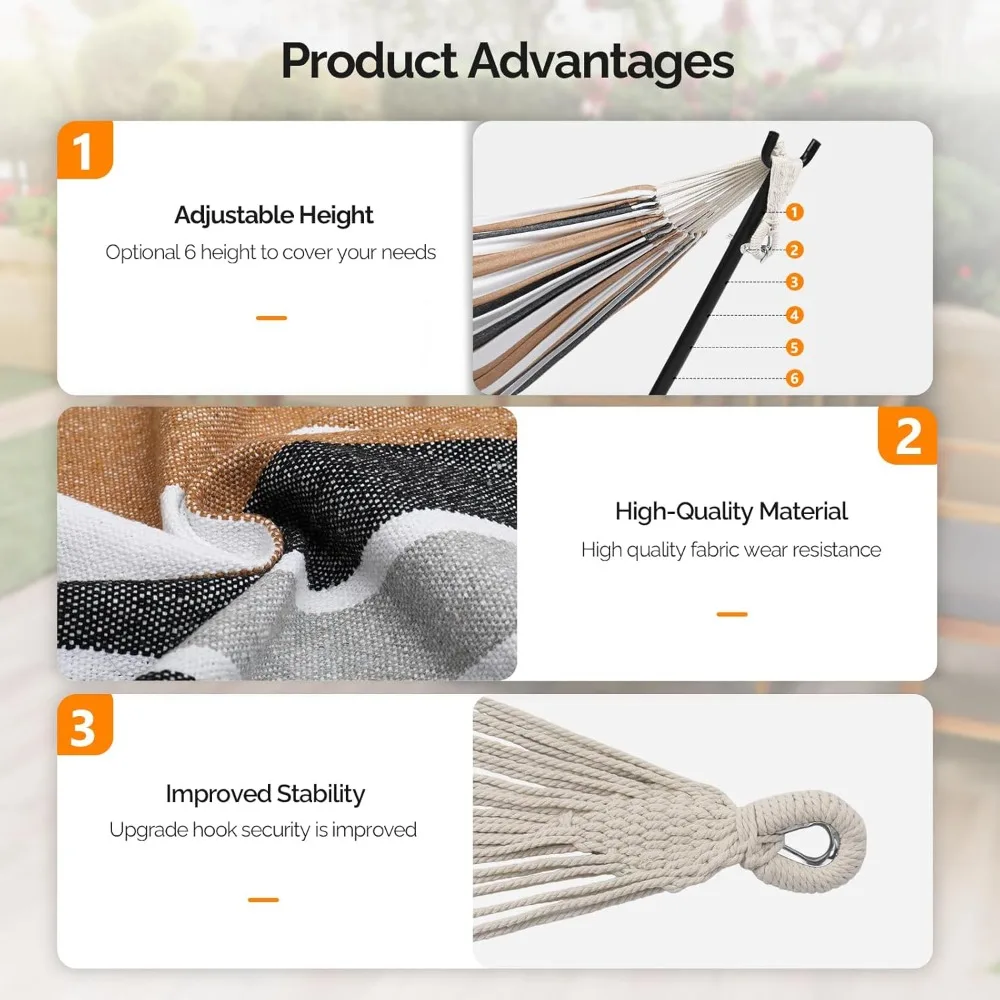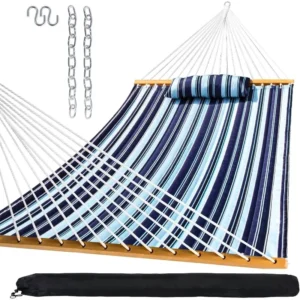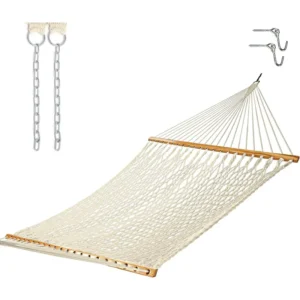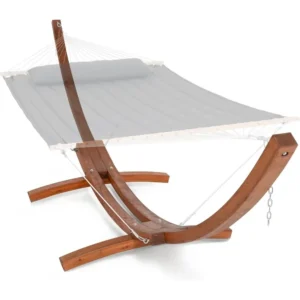Why Fabric Selection Makes or Breaks Your Outdoor Hammock Experience
The fabric of your outdoor hammock isn’t just about looks—it’s the foundation of your entire relaxation experience. Making the right choice directly impacts how long your hammock will last, how comfortable it feels, and how well it stands up to weather challenges.
Many hammock owners learn this lesson the hard way when their beautiful new hammock fades after just one season in the sun, develops unsightly mildew spots, or tears under normal use. The reality is that outdoor hammocks face unique challenges that indoor options never encounter:
- Constant exposure to UV rays that break down fibers
- Rain, morning dew, and humidity that can promote mildew growth
- Temperature fluctuations that stress fabric connections
- Wind that tests stitching and construction
Understanding the differences between indoor and outdoor hammock requirements helps you make better choices that balance comfort with durability. In this guide, we’ll explore everything you need to know about selecting a fabric hammock that delivers both luxurious relaxation and impressive longevity in outdoor conditions.
Understanding Outdoor Hammock Fabrics: A Comprehensive Guide
Synthetic Fabrics: Engineered for the Elements
When it comes to outdoor hammocks that can withstand nature’s challenges, synthetic fabrics lead the way with their engineered performance.
Polyester Hammocks
Polyester has become a go-to material for many outdoor hammock manufacturers for good reason:
- Excellent UV resistance prevents color fading even with constant sun exposure
- Strong water resistance means quicker drying after rain
- Relatively affordable compared to specialized outdoor fabrics
- Resists stretching and maintains shape over time
- Available in numerous colors and patterns
Polyester works best for hammocks that will remain outdoors for extended periods but can be brought in during severe weather. It strikes a good balance between durability and price, making it perfect for seasonal backyard use.
Nylon Hammocks
Nylon offers unmatched strength-to-weight benefits:
- Incredibly lightweight while maintaining impressive strength
- Packs down smaller than almost any other material
- Quick-drying properties excel in damp environments
- Soft hand-feel provides excellent comfort against skin
- Typically more expensive than basic polyester options
The exceptional portability of nylon makes it the preferred choice for camping hammocks and travel options. However, it generally has less UV resistance than polyester, so it’s better for occasional rather than permanent outdoor installation.
Premium Acrylic Fabrics (Sunbrella, Duracord)
These solution-dyed acrylics represent the gold standard for outdoor performance:
- Exceptional UV resistance with minimal fading over many years
- Solution-dying process embeds color throughout the fiber, not just on the surface
- Superior mildew resistance even in humid environments
- Soft, cotton-like feel without cotton’s susceptibility to mold
- Higher price point justified by significantly longer lifespan
These premium fabrics shine in permanent outdoor installations where the hammock will face constant exposure to elements. Our fabric hammock sets featuring these materials are ideal for homeowners seeking long-term outdoor relaxation solutions.
Olefin/Polypropylene Benefits
Olefin excels in high-moisture environments:
- Nearly impervious to water damage and mildew
- Chlorine-resistant making it perfect for poolside use
- Lighter weight than many alternative synthetics
- Naturally stain-resistant properties
- Environmentally friendly production compared to some synthetics
Olefin particularly excels in pool areas, beach houses, and extremely humid climates where moisture management is the primary concern.
Natural Fabrics: Finding the Balance Between Comfort and Durability
While synthetics dominate outdoor hammock materials, natural fibers offer unmatched comfort that keeps them in demand despite their limitations.
Cotton Hammocks
Nothing beats cotton for pure comfort:
- Unmatched softness and breathability against skin
- Natural temperature regulation keeps you cool in heat
- Traditional look and feel many users prefer
- More environmentally friendly production
- Usually more affordable initial purchase price
However, cotton’s outdoor limitations are significant:
– Highly susceptible to mildew and rot when wet
– Poor UV resistance leads to relatively quick degradation
– Requires more maintenance and careful storage
– May stretch significantly with use
For cotton hammocks to succeed outdoors, they need protective placement like covered porches or seasonal use with diligent storage during wet weather. Understanding the considerations for leaving different fabric types outdoors helps you set realistic expectations for natural materials.
Canvas Options
Canvas offers a middle ground between cotton and synthetics:
- More durable than standard cotton
- Heavier weight provides stability in light wind
- Traditional aesthetic with natural look
- Often treated for some water resistance
- More breathable than many synthetics
With proper treatments and care, canvas can work well in semi-protected outdoor environments, though it still doesn’t match the longevity of synthetics in fully exposed locations.
Fabric Comparison at a Glance: Making Informed Choices
| Fabric Type | Durability (1-5) | Weather Resistance | UV Resistance | Comfort | Maintenance | Relative Cost |
|---|---|---|---|---|---|---|
| Polyester | 4 | High | Good | 3 | Low | $$ |
| Nylon | 3 | Medium | Fair | 4 | Low | $$ |
| Acrylic (Sunbrella) | 5 | Excellent | Excellent | 4 | Low | $$$$ |
| Olefin | 4 | Excellent | Good | 3 | Very Low | $$$ |
| Cotton | 2 | Poor | Poor | 5 | High | $ |
| Canvas | 3 | Fair | Fair | 4 | Medium | $$ |
This comparison highlights why premium synthetic fabrics dominate the outdoor hammock market despite their higher price points. Their significantly longer lifespan and reduced maintenance needs often make them more economical over time. For enhanced comfort without sacrificing durability, consider our quilted fabric options that combine the best of both worlds.
Critical Performance Features for Long-Lasting Outdoor Hammocks
Beyond the basic fabric type, several specific performance features determine how well your hammock will withstand outdoor conditions.
UV Resistance
Ultraviolet radiation silently destroys outdoor fabrics by breaking down the molecular bonds in the material. This leads to fading, weakening, and eventual failure. Quality outdoor hammocks incorporate UV stabilizers and blockers within the fabric or as a treatment. Solution-dyed fabrics excel here because the color permeates the entire fiber rather than sitting on the surface where UV can attack it.
Water Repellency
Water-resistant treatments create a molecular barrier that causes water to bead up and roll off rather than soaking in. This feature:
– Prevents heavy waterlogging that stresses the hammock and support system
– Reduces drying time after rain
– Minimizes opportunities for mildew growth
– Maintains comfort during light rain or morning dew
Mold/Mildew Resistance
Fungal growth isn’t just unsightly—it weakens fabrics and creates potential health concerns. Quality outdoor hammocks incorporate antimicrobial treatments or use inherently fungus-resistant materials. This feature becomes increasingly important in humid or coastal environments.
Breathability
A hammock that traps heat and moisture against your body quickly becomes uncomfortable. Proper fabric hammock features for outdoor comfort include weave structures that allow airflow while maintaining strength. This balance between density for durability and openness for comfort distinguishes premium hammocks from basic options.
Fabric Strength Measurements
Technical specifications like denier (thread thickness) and tensile strength indicate how much weight and stress a fabric can handle. Higher denier numbers generally indicate thicker, stronger threads, though fiber quality and construction technique matter just as much as raw thickness.
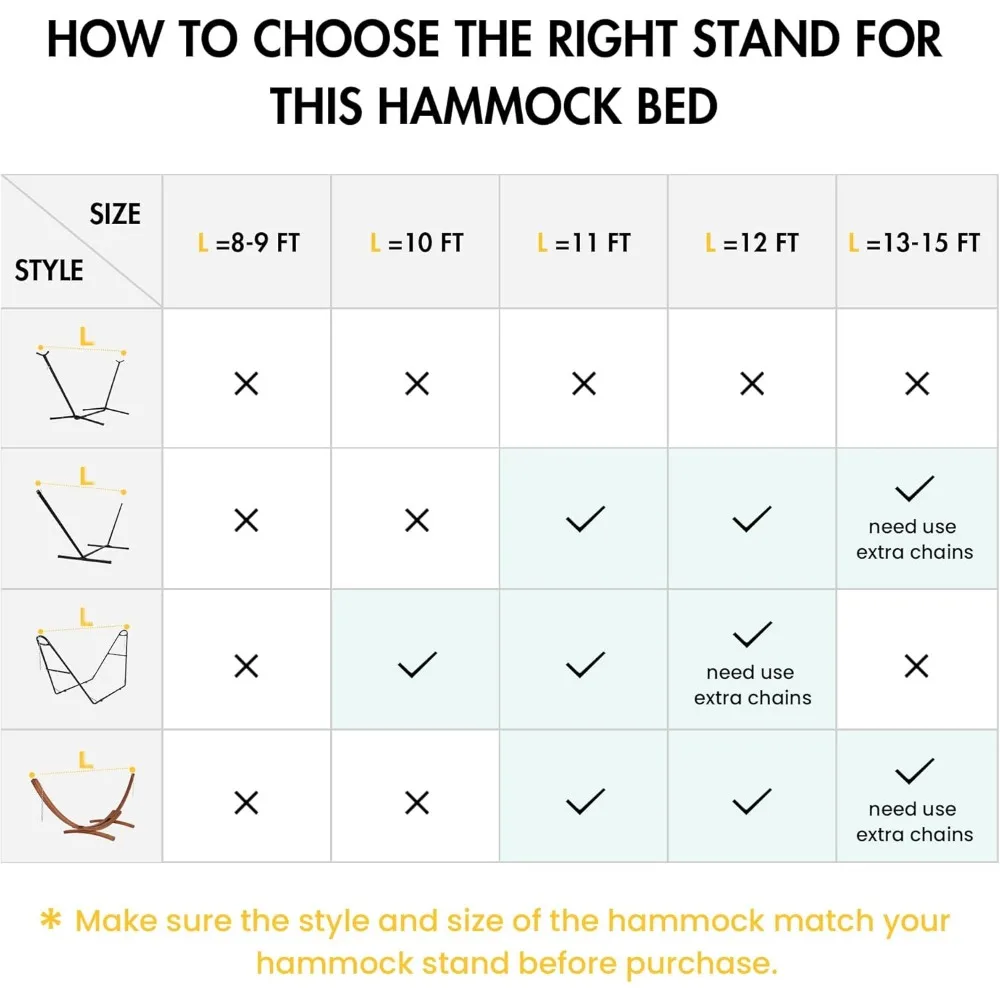
Finding Your Perfect Fit: Size, Comfort, and Capacity
The physical dimensions and design of your hammock directly impact your relaxation experience.
Size Options
Hammock sizes typically fall into three categories:
Single hammocks (4-5 feet wide) work well for individual relaxation and space-constrained areas. They’re lighter, more portable, and often less expensive.
Double hammocks (5-6 feet wide) provide room for two adults to sit side-by-side or one person to spread out completely. These versatile options represent the most popular size for backyard relaxation.
Family or extra-large hammocks (6+ feet wide) accommodate multiple people or provide luxurious space for one or two. Our double two-person hammock sets give you ample room to stretch out and truly relax.
Weight Capacity Considerations
Always look for stated weight capacity and choose a hammock rated for at least 25-50% more than the anticipated load. This safety margin accounts for:
- Dynamic movement and shifting weight
- Gradual stretching and wear of materials
- Unexpected additional users (like children joining adults)
- Prevention of premature failure points
Length and Width Impact
Longer hammocks (11+ feet between attachment points) generally provide flatter, more comfortable lounging than shorter options. Width determines how much you can spread out and whether the hammock can comfortably accommodate multiple users.
Design Differences
The basic hammock structure significantly affects comfort:
Spreader bar designs keep the fabric flat and open, making entry and exit easier. They provide a more bed-like surface but may be less stable for first-time users.
Gathered end (traditional) designs wrap around the user like a cocoon, providing more stability and often better weight distribution. They excel for sleeping but may feel more confining to some users.
Comfort Enhancers
Additional features like quilting, integrated pillows, and padding can dramatically improve comfort, especially for longer relaxation sessions. These features often distinguish premium hammocks from basic models.
Creating Your Outdoor Relaxation Space: Installation Essentials
Hanging Options for Every Setting
The perfect hammock loses its appeal without proper installation. Consider these options based on your available space:
Tree Hanging
When using trees as natural supports:
– Look for trees at least 12 inches in diameter for stability
– Maintain 12-15 feet between trees for proper hanging angles
– Use wide tree straps (at least 1 inch) to distribute pressure and protect bark
– Adjust height to allow for stretching (typically 4-5 feet off the ground initially)
Post Installation
For permanent installations without suitable trees:
– Use pressure-treated 4×4 or 6×6 posts buried at least 2 feet deep in concrete
– Place posts 2 feet further apart than your hammock’s total length
– Consider decorative options like carved posts or climbing plant supports
– Install eye bolts rated for at least 500 pounds
Hammock Stands
Stands offer versatility and portability:
– Steel stands provide maximum strength and durability
– Wooden stands offer aesthetic appeal with proper weather protection
– Portable stands allow for repositioning to follow shade or views
– Confirm stand dimensions match your hammock style and length
Following proper hammock installation requirements for safety not only enhances comfort but prevents accidents and extends the life of both the hammock and support system.
Essential Hardware and Setup Techniques
The connecting hardware between your hammock and support structure deserves careful consideration:
Weather-Resistant Hardware
– Stainless steel components resist rust and corrosion
– Galvanized hardware offers good protection at a lower price point
– Marine-grade options provide maximum protection in coastal environments
– Check weight ratings to ensure they exceed your hammock’s capacity
Connection Options
– S-hooks provide quick installation but less security
– Carabiners offer easy adjustment with locking capability
– Chains allow for height adjustments without retying knots
– Rope systems provide traditional aesthetics but require knot knowledge
The Perfect Angle
Achieving a 30-degree hanging angle:
– Creates the ideal balance between flat lying and secure cradling
– Minimizes stress on attachment points
– Provides proper weight distribution across the hammock fabric
– Enhances the natural ergonomic benefits of hammock relaxation
Our spreader bar hammock sets include appropriate hardware and detailed setup instructions to ensure proper installation right from the start.
Maximizing Your Investment: Care and Maintenance
Cleaning and Protection Strategies
Proper maintenance dramatically extends the life of any outdoor hammock:
Fabric-Specific Cleaning
– Synthetics generally allow mild soap and water cleaning
– Premium acrylics may benefit from specialized cleaners
– Natural fibers often require gentler handling and complete drying
– Always check manufacturer guidelines for specific recommendations
Maintenance Schedule
– Brush off debris weekly during heavy use seasons
– Deep clean at least twice yearly (spring and fall)
– Inspect for wear points or loose stitching monthly
– Apply fabric protector treatments annually for non-treated materials
Mold and Mildew Management
– Address spots immediately before they spread
– Use diluted vinegar solution (1:4 with water) for natural materials
– Consider commercial enzyme cleaners for stubborn growth
– Always dry completely before storage or reuse
Storage Practices
When not in use for extended periods:
– Ensure hammock is completely dry before storing
– Store in breathable bags or containers, never plastic
– Keep in climate-controlled environments when possible
– Fold loosely rather than tightly bundling
Finding the optimal placement for longevity helps minimize maintenance needs and extends your hammock’s useful life.
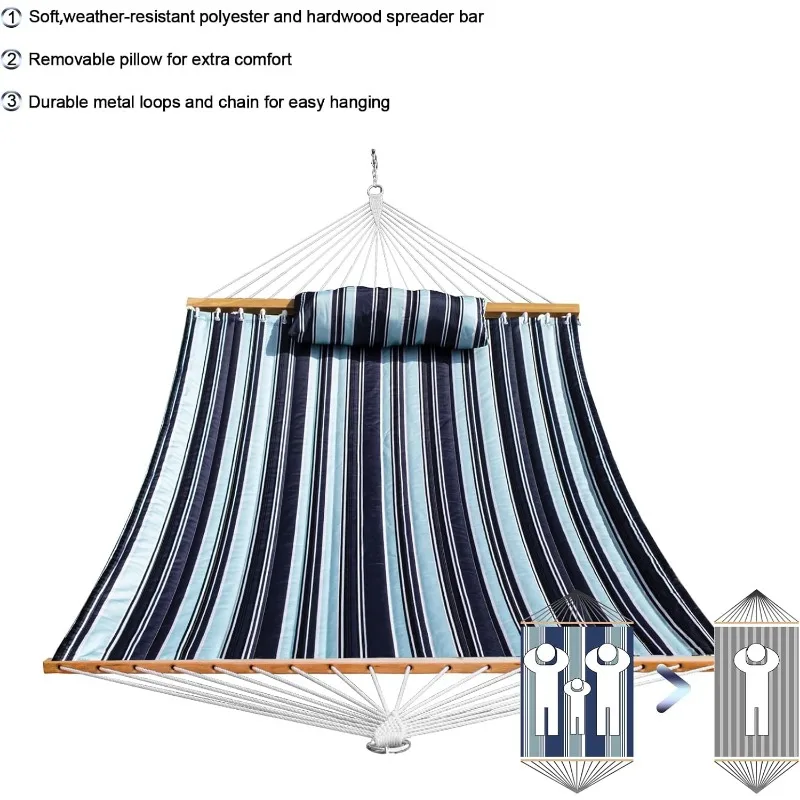
Avoiding Common Pitfalls: What Not to Do With Your Outdoor Hammock
Even quality hammocks can fail prematurely when common mistakes occur:
Aesthetic Over Performance
Don’t choose a hammock solely for its appearance. Beautiful patterns on indoor-grade fabric will quickly fade and deteriorate outdoors, leaving disappointment and wasted money.
Exceeding Weight Limits
Every hammock has a maximum weight capacity that should never be exceeded. Overloading leads to:
– Fabric tearing at stress points
– Support system failure
– Potential injury from falls
– Voided warranties
Improper Hanging Techniques
Hanging your hammock incorrectly creates both comfort and safety issues:
– Too tight creates excessive strain on fabric and supports
– Too loose causes uncomfortable sagging and poor body positioning
– Uneven hanging leads to sliding and potential falls
Weather Exposure Misjudgments
Be realistic about your local climate conditions:
– Don’t leave natural fiber hammocks out in rain
– Don’t expect budget materials to withstand harsh sun exposure
– Don’t forget about overnight dew even on clear days
Understanding proper safety considerations for outdoor hammock use helps prevent these common mistakes.
Lifestyle-Based Selection Guide: Finding Your Perfect Match
Your specific usage pattern should guide your hammock selection:
Backyard Lounger
If you primarily want a permanent backyard relaxation spot:
– Focus on weather resistance and UV protection
– Consider spreader bar designs for easier entry/exit
– Look for fade-resistant solution-dyed fabrics
– Invest in a quality stand if trees aren’t available
Camper/Hiker
For portable adventures:
– Prioritize lightweight nylon construction
– Look for quick-drying properties
– Consider integrated bug nets for wilderness use
– Focus on compact storage and easy setup
Poolside/Beachside
For water-adjacent relaxation:
– Choose chlorine-resistant fabrics like olefin
– Ensure hardware is marine-grade to prevent corrosion
– Look for quick-drying mesh or perforated designs
– Consider lighter colors to reduce heat absorption
Family Use
When multiple people will share the hammock:
– Focus on higher weight capacities (450+ pounds)
– Choose wider designs for comfortable sharing
– Look for reinforced edges and attachment points
– Consider quilted or padded options for additional comfort
Making the right choice when selecting outdoor fabric hammocks for your specific lifestyle ensures you’ll get the most enjoyment and value from your purchase.
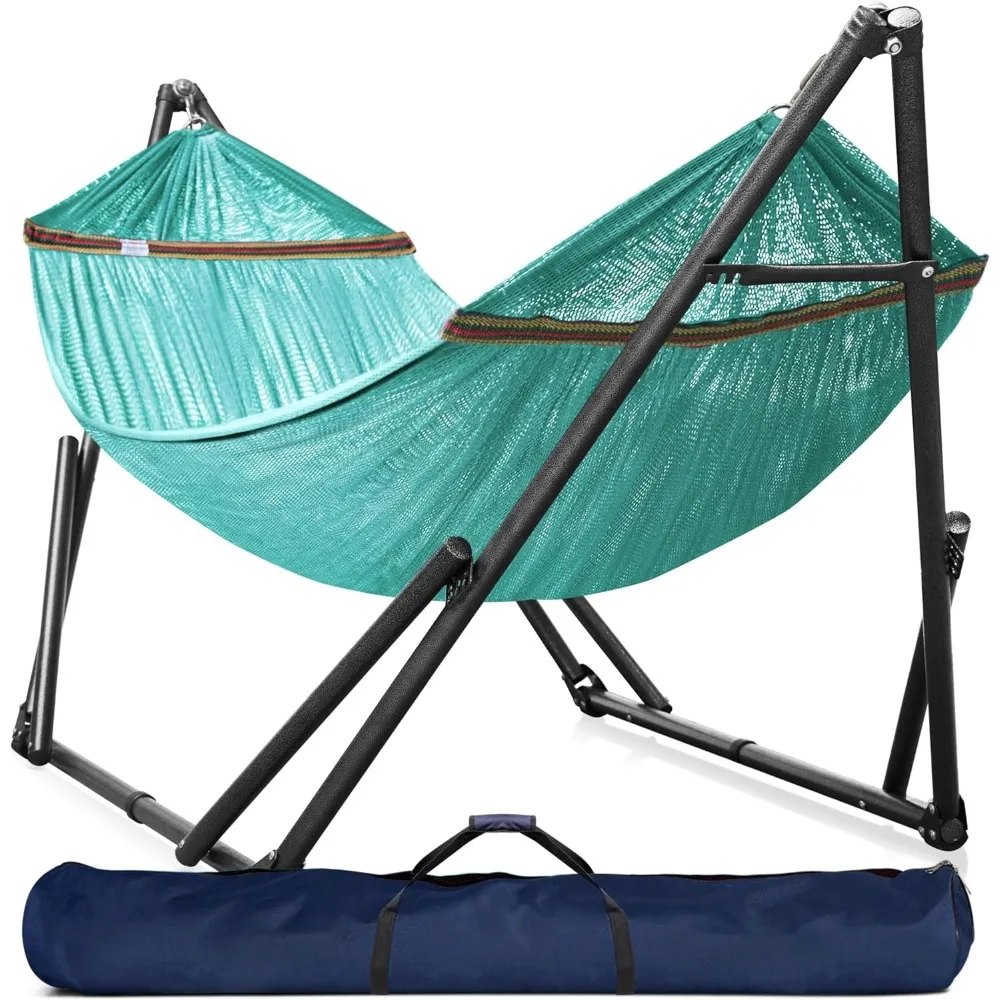
Classic Wooden Stand Hammock Sets, Heavy Duty Hammock Sets
$1,061.68 Select options This product has multiple variants. The options may be chosen on the product pageHammock Sets with Canopy, Heavy Duty Hammock Sets
$286.31 Select options This product has multiple variants. The options may be chosen on the product pageDouble / Two Person Hammock Sets, Rope Hammock Sets
Double Traditional Cotton Rope Hammock with Extension Chains – 450 lbs Capacity for Backyard & Patio$292.98 Select options This product has multiple variants. The options may be chosen on the product pageHeavy Duty Hammock Sets, Wooden Arc Stand Hammock Sets
$878.66 Select options This product has multiple variants. The options may be chosen on the product page
Your Outdoor Hammock Questions Answered
Can outdoor fabric hammocks be left outside year-round?
Premium outdoor hammocks made from solution-dyed acrylic or treated polyester can remain outdoors in moderate climates year-round, though removing during severe weather is recommended. Natural fiber hammocks should always be stored when not in use. Consider your local climate conditions—constant humidity, freezing temperatures, or intense sun exposure may require seasonal storage even for outdoor-rated hammocks.
What are the best cleaning methods for stubborn stains?
For synthetic fabrics, create a solution of mild dish soap, warm water, and a quarter cup of borax. Gently scrub the stain with a soft brush, then rinse thoroughly. For oil-based stains, apply cornstarch to absorb the oil before cleaning. For natural fabrics, use more diluted solutions and gentler scrubbing to prevent fiber damage.
Are there eco-friendly fabric options available?
Yes! Look for recycled polyester hammocks made from post-consumer plastic bottles, organic cotton options with water-based dyes, or hemp blends that require fewer pesticides to grow. Several manufacturers now offer fabrics with reduced environmental impact without sacrificing durability.
How long should a quality outdoor fabric hammock last?
With proper care, premium outdoor hammocks should last:
– Solution-dyed acrylic: 5-10 years of continuous outdoor use
– Quality polyester: 3-5 years outdoors
– Natural fibers with proper care: 2-3 seasons with storage between
Is there a break-in period for new hammock fabrics?
Yes, most hammocks benefit from a break-in period. Synthetic fabrics typically soften after 1-2 weeks of use. Natural fibers like cotton stretch and conform to your body over the first few weeks. This initial stretching may require readjustment of hanging height.
How do I know when it’s time to replace my hammock?
Replace your hammock when you notice:
– Visible thinning of fabric fibers
– Fraying at weight-bearing points
– Significant color fading that indicates UV damage
– Stretching that cannot be readjusted
– Any tears or holes, especially near attachment points
For seasonal transitions or extended storage, consider options for seasonal indoor storage to protect your investment.
Expert Recommendations: Investing in Quality for Years of Enjoyment
When making your final hammock selection, remember that true value extends beyond the initial price tag:
- Calculate cost-per-year by dividing the purchase price by expected lifespan
- Consider how frequently you’ll use the hammock
- Factor in your local climate conditions and exposure level
- Weigh the convenience of lower maintenance requirements
- Don’t underestimate the importance of comfort for regular use
Quality indicators to look for include:
– Double or triple stitching at stress points
– Reinforced edges and attachment points
– Brand reputation for durability and customer service
– Clear warranty terms and conditions
– Specific technical fabric specifications rather than vague descriptions
For those seeking maximum durability for frequent use or challenging environments, our heavy-duty hammock sets provide the robust construction and premium materials needed for years of trouble-free relaxation.
Indoor vs. Outdoor Fabrics: Understanding the Critical Differences
Not all “indoor/outdoor” labeled products are truly designed for continuous outdoor exposure. True outdoor fabrics differ in several critical ways:
- UV stabilizers and inhibitors embedded within the fiber structure
- Water-repellent treatments that penetrate beyond the surface
- Antimicrobial additives that prevent mold and mildew growth
- Higher tensile strength to withstand environmental stress
- Colorfast dyes that resist fading from sun exposure
You can identify genuine outdoor fabrics by:
– Looking for specific outdoor fabric brand names (Sunbrella, Olefin, Duracord)
– Checking for detailed UV protection ratings
– Reviewing warranty terms that specifically cover outdoor use
– Examining the tightness and uniformity of the weave
– Feeling the substantial weight compared to indoor-only fabrics
The investment in proper outdoor materials pays dividends through extended lifespan, reduced maintenance, and continued enjoyment year after year.

